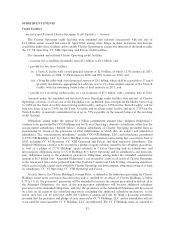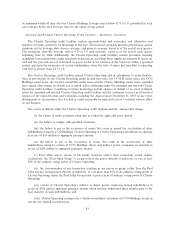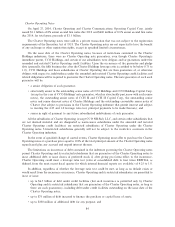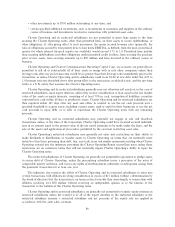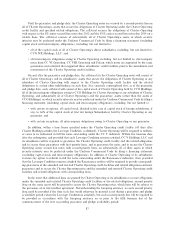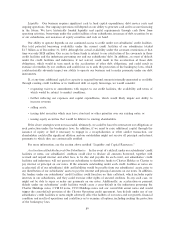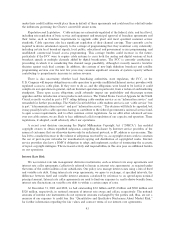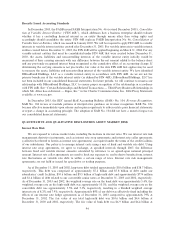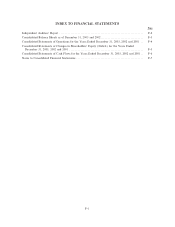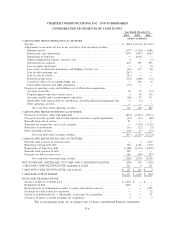Charter 2003 Annual Report Download - page 94
Download and view the complete annual report
Please find page 94 of the 2003 Charter annual report below. You can navigate through the pages in the report by either clicking on the pages listed below, or by using the keyword search tool below to find specific information within the annual report.Increasing Programming Costs. Programming has been, and is expected to continue to be, our largest
operating expense item. In recent years, the cable industry has experienced a rapid escalation in the cost of
programming, particularly sports programming. This escalation may continue, and we may not be able to pass
programming cost increases on to our customers. As measured by programming costs, and excluding premium
services (substantially all of which were renegotiated and renewed in 2003), as of February 18, 2004,
approximately 34% of our current programming contracts are scheduled to expire by the end of 2004, and
approximately another 11% by the end of 2005. There can be no assurance that these agreements will be
renewed on favorable or comparable terms. The inability to fully pass these programming cost increases on to
our customers would have an adverse impact on our cash Öow and operating margins.
Class A Common Stock and Notes Price Volatility. The market price of our Class A common stock and
the publicly-traded notes issued by us and our subsidiaries has been and is likely to continue to be highly
volatile. We expect that the price of our securities may Öuctuate in response to various factors, including the
factors described throughout this section and various other factors, which may be beyond our control. These
factors beyond our control could include: Ñnancial forecasts by securities analysts; new conditions or trends in
the cable or telecommunications industry; general economic and market conditions and speciÑcally, conditions
related to the cable or telecommunications industry; any further downgrade of our debt ratings; announcement
of the development of improved or competitive technologies; the use of new products or promotions by us or
our competitors; changes in accounting rules; new regulatory legislation adopted in the United States; and any
action taken or requirements imposed by Nasdaq if our Class A common stock trades below $1.00 per share
for over 30 consecutive trading days.
In addition, the securities market in general, and the Nasdaq National Market and the market for cable
television securities in particular, have experienced signiÑcant price Öuctuations. Volatility in the market price
for companies may often be unrelated or disproportionate to the operating performance of those companies.
These broad market and industry factors may seriously harm the market price of our Class A common stock
and our subsidiaries' notes, regardless of our operating performance. In the past, securities litigation has often
commenced following periods of volatility in the market price of a company's securities, and several purported
class action lawsuits were Ñled against us in 2001 and 2002, following a decline in our stock price.
Economic Slowdown; Global ConÖict. It is diÇcult to assess the impact that the general economic
slowdown and global conÖict will have on future operations. However, the economic slowdown has resulted
and could continue to result in reduced spending by customers and advertisers, which could reduce our
revenues, and also could aÅect our ability to collect accounts receivable and maintain customers. In addition,
any prolonged military conÖict would materially and adversely aÅect our revenues from our systems providing
services to military installations. If we experience reduced operating revenues, it could negatively aÅect our
ability to make expected capital expenditures and could also result in our inability to meet our obligations
under our Ñnancing agreements. These developments could also have a negative impact on our Ñnancing and
variable interest rate agreements through disruptions in the market or negative market conditions.
Long-Term Indebtedness Ì Change of Control Payments. We may not have the ability to raise the
funds necessary to fulÑll our obligations under the Charter convertible senior notes or the notes and credit
facilities of our subsidiaries following a change of control. Under the indentures governing the Charter
convertible senior notes, upon the occurrence of speciÑed change of control events, including certain speciÑed
dispositions of our stock by Mr. Allen, we are required to oÅer to repurchase all of the outstanding Charter
convertible senior notes. However, we may not have suÇcient funds at the time of the change of control event
to make the required repurchase of the Charter convertible senior notes and our subsidiaries are limited in
their ability to make distributions or other payments to us to fund any required repurchase. In addition, a
change of control under our subsidiaries' credit facilities and indentures governing their notes would require
the repayment of borrowings under those credit facilities and indentures. Because such credit facilities and
notes are obligations of our subsidiaries, the credit facilities and the notes would have to be repaid by our
subsidiaries before their assets could be available to us to repurchase the Charter convertible senior notes. Our
failure to make or complete a change of control oÅer would place us in default under the Charter convertible
senior notes. The failure of our subsidiaries to make a change of control oÅer or repay the amounts outstanding
92


